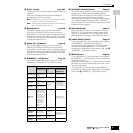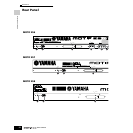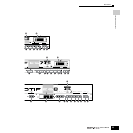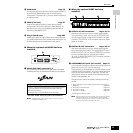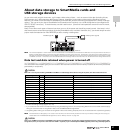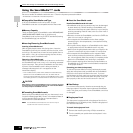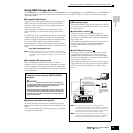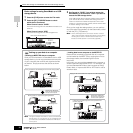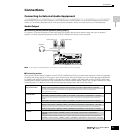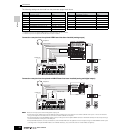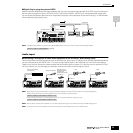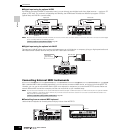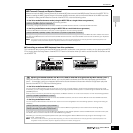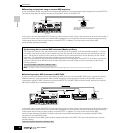
About data storage to SmartMedia cards and USB storage devices
29
Owner’s Manual
Setting Up
Using USB storage devices
When using USB storage devices, make sure to connect them to the USB TO DEVICE connector, and follow the important
precautions below.
■ Compatible USB devices
Connect only a USB storage device (such as hard disk, CD-
ROM, flash disk and other drives) to the USB TO DEVICE
connector. Other devices such as a computer keyboard or
mouse cannot be used.
Both bus-powered (powered by the host device) or self-
powered (battery or external power supply) types can be
used.
The MOTIF ES does not necessarily support all commercially
available USB storage devices. Yamaha cannot guarantee
operation of USB storage devices that you purchase. Before
purchasing USB storage devices, please consult your
Yamaha dealer, or an authorized Yamaha distributor (see list
at end of the Owner’s Manual) for advice, or see the following
page:
http://www.yamahasynth.com/
n Although CD-R/W drives can be used to load data to the instrument,
they cannot be used for saving data. However, you can transfer data
to a computer and save data to a CD using the CD-R/W drive on the
computer.
■ Formatting USB storage media
When a USB storage device is connected or media is
inserted, a “Disk or card unformatted” message may appear
in the LCD display, indicating that the device or media must
be formatted for use. Execute the Format operation in the File
mode (page 268).
■ Protecting your data (write-protect)
To prevent important data from being inadvertently erased,
apply the write-protect provided with each storage device or
media.
If you are saving data to the USB storage device, make sure
to remove the write-protect.
Precautions when using the USB TO DEVICE
connector
• Never turn the USB device’s power on/off and never plug/unplug
the USB cable when the connected USB storage device is the self-
powered type. Doing so may result in the operation of the
synthesizer “freezing” or hanging up.
• While the instrument is accessing data (such as in the Save, Load
and Delete operations in the File mode), do NOT unplug the USB
cable, do NOT remove the media from the device, and do NOT turn
the power off to either device. Doing so may corrupt the data on
either or both devices.
CAUTION
USB connector types
There are two different types of USB connectors, and the
rear panel of the instrument features both. Take care not
to confuse the two.
■ USB TO HOST connector
This type is used to connect the instrument to a
computer, and allows you to transfer MIDI data between
the devices. Unlike MIDI, USB can handle multiple ports
via a single cable.
USB cables have different connectors on each end: the
A type and the B type. Connect the A type to your
computer and the B type to the USB TO HOST
connector.
■ USB TO DEVICE connector
This type is used to connect the instrument to a USB
storage device, and allows you to save data you’ve
created to the connected device, as well as load data
from the connected device. Save and Load operations
are executed in the File mode.
USB cables have different connectors on each end: the
A type and the B type. Connect the A type to the USB TO
HOST connector and the B type to the USB storage
device.
n The computer cannot access the USB storage device
connected to the MOTIF ES’s USB TO DEVICE connector, even
if connecting as shown above. Only from the File mode on the
instrument itself can you access the data on the USB storage
device connected to the USB TO DEVICE connector.
n Though the MOTIF ES supports the USB 1.1 standard, you can
connect and use a USB 2.0 storage device with the MOTIF ES.
However, note that the transfer speed complies to USB 1.1.
MOTIF ES
MUSIC PRODUCTION SYNTHESIZER
MIDI data transfer
Connecting to a computer
Connecting to a
USB storage device
(hard disk, CD-ROM,
flash disk and other
drives)
Saving/Loading data in
the File mode (page 266)
A typeB type
USB TO DEVICE
connector
USB TO HOST
connector



